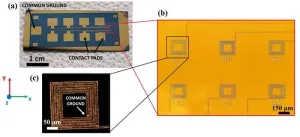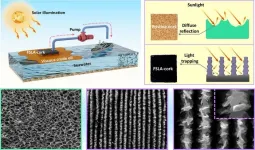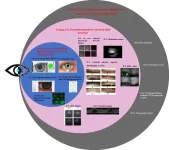(Press-News.org) WASHINGTON, April 23, 2024 — Neural stimulation is a medical technique used to treat many illnesses affecting the nervous system. It involves applying energy to neurons to encourage them to grow and make connections with their neighbors. Treatments for epilepsy can often include neural stimulation, and similar treatments exist for Parkinson’s disease, chronic pain, and some psychiatric illnesses.
In the Journal of Vacuum Science & Technology A, by AIP Publishing, researchers from the University of Minnesota deployed an array of microscopic coils — microcoils — to create a magnetic field and stimulate individual neurons.
Existing devices are effective, but lack the necessary precision needed for some applications, such as cochlear implants or vagus nerve stimulators.
“There are several neurostimulation devices on the market – some are already FDA-approved for patient trials, some are pending approval,” said author Renata Saha. “But each of them has one caveat – they stimulate a large population of neurons, including neighboring cells that are not supposed to be stimulated. The medical device industry is in search of a device or technique that can stimulate neurons at a single-cell resolution.”
Instead of using an electrode, Saha and her team turned to magnetic coils of wire. Over two centuries ago, physicist Michael Faraday described how electric current running through a coil of wire can create a magnetic field. This magnetic field can then induce an electric field in any nearby neurons — the same effect created by an electrode but much more precise. However, this technique comes with a major downside.
“To achieve the desired threshold of electric field capable of stimulating neurons, the amount of current these microcoils need to drive is extremely high,” said Saha. “It is almost three times the amount of current that needs to drive an electrode to achieve the same threshold.”
To solve this problem, the team made two improvements. First, rather than a single microcoil, they used an array of eight coils, which combined can induce electric fields using much less current per coil. The authors made further improvement to these microcoil arrays by employing soft magnetic materials, which boost the magnetic strength of the coils.
“Adding these soft magnetic materials at the core of the microcoils increases the electric field without the need to increase the current through the microcoils,” said Saha.
The researchers constructed a prototype of their coil array, called MagPatch, and encapsulated it within a biocompatible coating. They then tested it with human neuroblastoma cells to demonstrate its effectiveness. The cells were affected by the magnetic fields without being harmed by the coating, suggesting the potential to use this device in clinical settings.
The authors plan to continue developing and testing the MagPatch device to ensure its safety and utility. They hope it helps to improve the next generation of cochlear implants.
###
The article “Planar microcoil arrays for in vitro cellular-level micromagnetic activation of neurons” is authored by Renata Saha, Onri Jay Benally, Sadegh Faramarzi, Robert P. Bloom, Kai Wu, Denis Tonini, Maple Shiao, Susan A. Keirstead, Walter C. Low, Theoden I. Netoff, and Jian-Ping Wang. It will appear in Journal of Vacuum Science & Technology B on April 23, 2024 (DOI: 10.1116/6.0003362). After that date, it can be accessed at https://doi.org/10.1116/6.0003362.
ABOUT THE JOURNAL
Journal of Vacuum Science & Technology B, an AVS journal published by AIP Publishing, is devoted to publishing reports of original research, letters, and review articles covering multiple disciplines with a focus on microelectronics and nanotechnology. See https://avs.scitation.org/journal/jvb.
ABOUT AVS
AVS is an interdisciplinary, professional society with some 4,500 members worldwide. Founded in 1953, AVS hosts local and international meetings, publishes five journals, serves members through awards, training and career services programs, and supports networking among academic, industrial, government, and consulting professionals. Its members come from across the fields of chemistry, physics, biology, mathematics, engineering, and business and share a common interest in basic science, technology development and commercialization related to materials, interfaces, and processing. https://www.avs.org.
###
END
Magnetic microcoils unlock targeted single-neuron therapies for neurodegenerative disorders
MagPatch array features single-neuron precision for advanced cochlear implants and vagus nerve stimulation in the future
2024-04-23
ELSE PRESS RELEASES FROM THIS DATE:
Laser-treated cork absorbs oil for carbon-neutral ocean cleanup
2024-04-23
WASHINGTON, April 23, 2024 – Oil spills are deadly disasters for ocean ecosystems. They can have lasting impacts on fish and marine mammals for decades and wreak havoc on coastal forests, coral reefs, and the surrounding land. Chemical dispersants are often used to break down oil, but they often increase toxicity in the process.
In Applied Physics Letters, by AIP Publishing, researchers from Central South University, Huazhong University of Science and Technology, and Ben-Gurion University of the Negev used laser treatments to transform ordinary ...
COVID-19 vaccination and incidence of pediatric SARS-CoV-2 infection and hospitalization
2024-04-23
About The Study: The findings of this study including 3.9 million children suggest that vaccination against SARS-CoV-2 was associated with significant reductions in COVID-19 incidence and hospitalizations among children in California.
Authors: Justin V. Remais, Ph.D., of the University of California, Berkeley, is the corresponding author.
To access the embargoed study: Visit our For The Media website at this link https://media.jamanetwork.com/
(doi:10.1001/jamanetworkopen.2024.7822)
Editor’s Note: Please see the article for additional information, including other authors, author contributions and affiliations, conflict of interest and ...
Long-term taste and smell outcomes after COVID-19
2024-04-23
About The Study: Taste dysfunction as measured objectively was absent one year after exposure to COVID-19 while some smell loss remained in nearly one-third of individuals with this exposure, likely explaining taste complaints of many individuals with post–COVID-19 condition in this study of 340 individuals with and 434 individuals without prior COVID-19. Infection with earlier untyped and Alpha variants was associated with the greatest degree of smell loss.
Authors: Shima T. Moein, M.D., Ph.D., of the University of Pennsylvania ...
Artificial intelligence to be used for the detection of common eye disease
2024-04-23
Dry Eye Disease (DED) is one of the more common eye diseases, affecting up to 30% of the world’s population. This disease can affect many different types of people and can wind up being a great hindrance to their overall quality of life. Early screening and prognosis is vital to the patient’s progression with the disease. However, this can be difficult. In this study, researchers aim to use artificial intelligence (AI) to aid in early screening and prognosis of DED. Not only can the use of AI make screening more accessible for ...
A roadmap for digital neuroscience
2024-04-23
Neuroscience has entered a new, digital phase. The combination of brain research with supercomputing in large-scale, multi-disciplinary research collaborations has enabled an innovative approach to deciphering the brain, using powerful scientific technologies and data ressources. These developments open up new possibilities for brain research, medicine and technology. A position paper by over 100 authors, now published in the journal Imaging Neuroscience, summarises the current status and identifies ...
Radiologists propose actions to combat climate change
2024-04-23
OAK BROOK, Ill. – A diverse writing group—lead by authors at the University of Toronto—have developed an approach for radiology departments and practices to reduce their greenhouse gas emissions and become more resilient to the effects of climate change. They outlined their action plan in a Radiology in Focus article, published today in Radiology, a journal of the Radiological Society of North America (RSNA).
“Rising greenhouse gas emission levels lead to climate change, extreme weather events and worsening air pollution with downstream adverse health effects,” said lead author Kate Hanneman, M.D., M.P.H., vice chair of research ...
SwRI to discuss connected vehicle data exchanges, AI tools at 2024 ITS America Conference & Expo
2024-04-23
SAN ANTONIO — April 23, 2024 — During this week’s ITS America Conference & Expo, Southwest Research Institute will share its latest intelligent transportation systems (ITS) research designed to integrate connected vehicle data exchanges and artificial intelligence into public transportation infrastructure.
“SwRI’s ITS solutions are designed to improve safety for the traveling public using software that helps transportation agencies operate more efficiently,” said Josh Johnson, ...
Announcing the second cohort of the Hevolution/AFAR new investigator awardees in aging biology and geroscience research
2024-04-23
New York, NY —The American Federation for Aging Research (AFAR) is pleased to announce the second cohort of the Hevolution/AFAR New Investigator Awards in Aging Biology and Geroscience Research, a grant program to enable early-career investigators with labs in the US and Canada to advance research projects in basic biology of aging, as well as geroscience projects that translate advances in basic research on aging biology from the laboratory to the clinic, paving the way for healthspan-expanding therapeutics and treatments. ...
Advances in understanding the evolution of stomach loss in agastric fishes
2024-04-23
Living beings can evolve to lose biological structures due to potential survival benefits from such losses. For example, certain groups of ray-finned fishes show such regressive evolution—medakas, minnows, puffera, and wrasses do not have a stomach in the gastrointestinal tract, making them agastric or stomachless fishes. However, the specific evolutionary mechanisms underlying the evolution of agastric fishes remains unclear.
Studies about Slc26a9—a molecular transporter highly expressed in the stomach of many species—in fishes provided the initial clue. Researchers ...
Social media affects people’s views on mental illness
2024-04-23
COLUMBUS, Ohio – Even subtle differences in the wording of social media messages may be enough to sway young people’s beliefs about depression and anxiety and their treatment.
In a new study, researchers found that college students were more optimistic about the possibility of successfully treating mental health problems after they read social media messages conveying what is called a “growth mindset.”
But social media posts written with a “fixed mindset” led young people to feel that depression and anxiety were more stable and innate, and not so easy to treat.
Growth mindset is the belief that a feature, such ...
LAST 30 PRESS RELEASES:
Neuroscientists devise formulas to measure multilingualism
New prostate cancer trial seeks to reduce toxicity without sacrificing efficacy
Geometry shapes life
A CRISPR screen reveals many previously unrecognized genes required for brain development and a new neurodevelopmental disorder
Hot flush treatment has anti-breast cancer activity, study finds
Securing AI systems against growing cybersecurity threats
Longest observation of an active solar region
Why nail-biting, procrastination and other self-sabotaging behaviors are rooted in survival instincts
Regional variations in mechanical properties of porcine leptomeninges
Artificial empathy in therapy and healthcare: advancements in interpersonal interaction technologies
Why some brains switch gears more efficiently than others
UVA’s Jundong Li wins ICDM’S 2025 Tao Li Award for data mining, machine learning
UVA’s low-power, high-performance computer power player Mircea Stan earns National Academy of Inventors fellowship
Not playing by the rules: USU researcher explores filamentous algae dynamics in rivers
Do our body clocks influence our risk of dementia?
Anthropologists offer new evidence of bipedalism in long-debated fossil discovery
Safer receipt paper from wood
Dosage-sensitive genes suggest no whole-genome duplications in ancestral angiosperm
First ancient human herpesvirus genomes document their deep history with humans
Why Some Bacteria Survive Antibiotics and How to Stop Them - New study reveals that bacteria can survive antibiotic treatment through two fundamentally different “shutdown modes”
UCLA study links scar healing to dangerous placenta condition
CHANGE-seq-BE finds off-target changes in the genome from base editors
The Journal of Nuclear Medicine Ahead-of-Print Tip Sheet: January 2, 2026
Delayed or absent first dose of measles, mumps, and rubella vaccination
Trends in US preterm birth rates by household income and race and ethnicity
Study identifies potential biomarker linked to progression and brain inflammation in multiple sclerosis
Many mothers in Norway do not show up for postnatal check-ups
Researchers want to find out why quick clay is so unstable
Superradiant spins show teamwork at the quantum scale
Cleveland Clinic Research links tumor bacteria to immunotherapy resistance in head and neck cancer
[Press-News.org] Magnetic microcoils unlock targeted single-neuron therapies for neurodegenerative disordersMagPatch array features single-neuron precision for advanced cochlear implants and vagus nerve stimulation in the future








